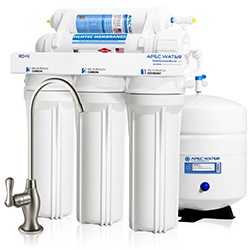Green Roofs or the idea that you could grow plants on the roof as a form of insulation and an absorber of water are gaining traction in the US Market. This new, some would say radical, idea is actually not new for people who live in rammed earth homes and underground or planned caves. These structures seed what are their roofs with grass. In the summer they allow the grass to grow tall which adds insulation value to the home. Green Roofs are this idea transferred up in the air.
I think that this idea would work best for low slope roofs with some access to enjoy the greenery. We have a sharply sloped roof so it would not work on our house. We have low sloped roofs on the garage and a very large shed so we could do Green Roofs there. It has the advantage of some carbon sequestration as well, depending on what you do with the green waste.
http://www.toolbase.org/Technology-Inventory/Roofs/green-roofs

Green roofs, also called living or planted roofs, are systems of living plants and vegetation installed on the roof of an existing or new structure. The green roof concept is not new. The Hanging Gardens of Babylon constructed around 500 B.C. were perhaps one of the first green roof systems.  Terrace structures were built over arched stone beams and waterproofed with layers of reeds and thick tar on which plants and trees were placed in soil.
Terrace structures were built over arched stone beams and waterproofed with layers of reeds and thick tar on which plants and trees were placed in soil.
Popular in Europe for decades, technology has improved upon the ancient systems, making green roofs available in and appropriate for nearly all climates and areas of the United States. All green roof systems consist of four basic components: a waterproofing layer, a drainage layer, a growing medium, and vegetation. Some green roofs also include root retention and irrigation systems, but these are not essential.
Green roof systems are often broken down into two types—extensive and intensive systems. An extensive system features low-lying plants such as succulents, mosses, and grasses. They require relatively thin layers of soil (1-6 inches), and plants usually produce a few inches of foliage. Extensive systems have less of an impact on the roof structure, weighing 10-50 pounds per square foot on average, and are generally accessible only for routine maintenance. Most residential applications are composed of extensive green roof systems. Intensive systems feature deeper soil and can support larger plants including crops, shrubs, and trees. Intensive systems can be harder to maintain, depending on the plants used, and are much heavier than extensive systems—they range from 80 to more than 120 pounds per square foot. Intensive systems are typically designed to be accessible to building inhabitants for relaxation and/or harvesting.
:}
For people who are “doing it” so to speak:
http://www.hadj.net/green-roofs/project-info.html
Welcome to the project! We intend to examine the feasibility of green roofs (extensive roof gardens) for residential scale construction. As you know, green roofs are common in Germany, France, Swizerland, and England, and are gaining a foothold in Canada and the U.S.
However, the vast majority of these roofs are commercial scale. The total area of residential roof surface, compared to commercial roof surface, is much larger and has a much more profound impact on the environment. Also, the largest and fastest growing encroachment on open space and riparian waterways is not commercial but residential development.
There are several challenges to developing a residential market:
- The intial cost of green roofs is higher (however, their life cycle cost is competitive with conventional roofs).
- Builders and developers want to offer a low sticker price for their product. They are responding to a market that does not frequently calculate life cycle costs.
- Weight: the 3″ to 6″ of soil plus geotextiles on a roof can require added structure. In seismic zones there is a concern in that more weight is placed higher up in a structure.
- The simple novelty of green roofs. I remember when the U.S. construction industry was talking about going metric, 35 years ago.
:}
AND:
http://www.associatedcontent.com/article/49803/doityourself_green_roofs_eco_roof_installation.html
Home Improvement for the Planet
Green roofs or eco roofs are an excellent way to reduce energy costs and reduce urban “heat island” effects that increase atmospheric temperatures. A green roof is a roof that is covered with vegetation. Green roofs are still relatively scarce in the United States today but appeared throughout the Midwest prairie homes of decades gone by. They are common throughout European commercial and residential areas today, covering over 100 million square feet of rooftops.
In both commercial and residential applications, green roofs offer many benefits to property owners. Green roofs reduce energy costs by adding insulation in winter and absorbing heat in summer. Estimates of energy savings range from 6-50% depending on the roof size. When installed in new construction, the incorporation of a green roof into the project’s design allows a reduction in the size of heating and cooling systems needed. This adds an upfront savings s smaller units may be installed for smaller heating and cooling loads. In today’s housing market, energy savings equals increased property value. Some green roof projects are eligible for tax credits and other “green” incentives. Green roofs transform impervious surfaces such as tar and asphalt into useable green space that absorbs solar radiation and carbon dioxide.
Until now, green roofs in residential areas have been outnumbered by commercial coverage because the task of installing a green roof can be overwhelming for individual home owners. In part this is due to expense but also attributed to a lack of knowledge in general about green roofs, their benefits and how to install them. As such an important feature of a home’s structural soundness, the thought of an “outside the norm” roof treatment can be intimidating.
:}
For much more information please go to their sites and thank them for being pioneers.










